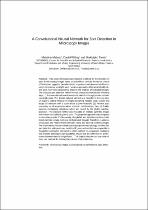JavaScript is disabled for your browser. Some features of this site may not work without it.
- ResearchSpace
- →
- Research Publications/Outputs
- →
- Journal Articles
- →
- View Item
| dc.contributor.author |
Mabaso, Matsilele A

|
|
| dc.contributor.author |
Withey, Daniel J

|
|
| dc.contributor.author |
Twala, B

|
|
| dc.date.accessioned | 2019-12-12T09:20:22Z | |
| dc.date.available | 2019-12-12T09:20:22Z | |
| dc.date.issued | 2019-08 | |
| dc.identifier.citation | Mabaso, M.A., Withey, D.J. & Twala, B. 2019. A convolutional neural network for spot detection in microscopy images. Communications in Computer and Information Science, pp. 132-145 | en_US |
| dc.identifier.issn | 1865-0929 | |
| dc.identifier.uri | https://link.springer.com/chapter/10.1007/978-3-030-29196-9_8 | |
| dc.identifier.uri | https://doi.org/10.1007/978-3-030-29196-9_8 | |
| dc.identifier.uri | https://link.springer.com/chapter/10.1007%2F978-3-030-29196-9_8 | |
| dc.identifier.uri | http://hdl.handle.net/10204/11260 | |
| dc.description | Copyright: 2019 Springer Verlag. This is a pre-print version. The definitive version of the work is published in Communications in Computer and Information Science, pp 132-145 | en_US |
| dc.description.abstract | This paper developed and evaluated a method for the detection of spots in microscopy images. Spots are subcellular particles formed as a result of biomarkers tagged to biomolecules in a specimen and observed via fluorescence microscopy as bright spots. Various approaches that automatically detect spots have been proposed to improve the analysis of biological images. The proposed spot detection method named, detectSpot includes the following steps: (1) A convolutional neural network is trained on image patches containing single spots. This trained network will act as a classifier to the next step. (2) Apply a sliding-window on images containing multiple spots, classify and accept all windows with a score above a given threshold. (3) Perform post-processing on all accepted windows to extract spot locations, then, (4) finally, suppress overlapping detections which are caused by the sliding window-approach. The proposed method was evaluated on realistic synthetic images with known and reliable ground truth. The proposed approach was compared to two other popular CNNs namely, GoogleNet and AlexNet and three traditional methods namely, Isotropic Undecimated Wavelet Transform, Laplacian of Gaussian and Feature Point Detection, using two types of synthetic images. The experimental results indicate that the proposed methodology provides fast spot detection with precision, recall and F_score values that are comparable to GoogleNet and higher compared to other methods in comparison. Statistical test between detectSpot and GoogleNet shows that the difference in performance between them is insignificant. This implies that one can use either of these two methods for solving the problem of spot detection. | en_US |
| dc.language.iso | en | en_US |
| dc.publisher | Springer Verlag | en_US |
| dc.relation.ispartofseries | Workflow;22827 | |
| dc.subject | Microscopy images | en_US |
| dc.subject | Convolutional neural network | en_US |
| dc.subject | Spot detection | en_US |
| dc.title | A convolutional neural network for spot detection in microscopy images | en_US |
| dc.type | Article | en_US |
| dc.identifier.apacitation | Mabaso, M. A., Withey, D. J., & Twala, B. (2019). A convolutional neural network for spot detection in microscopy images. http://hdl.handle.net/10204/11260 | en_ZA |
| dc.identifier.chicagocitation | Mabaso, Matsilele A, Daniel J Withey, and B Twala "A convolutional neural network for spot detection in microscopy images." (2019) http://hdl.handle.net/10204/11260 | en_ZA |
| dc.identifier.vancouvercitation | Mabaso MA, Withey DJ, Twala B. A convolutional neural network for spot detection in microscopy images. 2019; http://hdl.handle.net/10204/11260. | en_ZA |
| dc.identifier.ris | TY - Article AU - Mabaso, Matsilele A AU - Withey, Daniel J AU - Twala, B AB - This paper developed and evaluated a method for the detection of spots in microscopy images. Spots are subcellular particles formed as a result of biomarkers tagged to biomolecules in a specimen and observed via fluorescence microscopy as bright spots. Various approaches that automatically detect spots have been proposed to improve the analysis of biological images. The proposed spot detection method named, detectSpot includes the following steps: (1) A convolutional neural network is trained on image patches containing single spots. This trained network will act as a classifier to the next step. (2) Apply a sliding-window on images containing multiple spots, classify and accept all windows with a score above a given threshold. (3) Perform post-processing on all accepted windows to extract spot locations, then, (4) finally, suppress overlapping detections which are caused by the sliding window-approach. The proposed method was evaluated on realistic synthetic images with known and reliable ground truth. The proposed approach was compared to two other popular CNNs namely, GoogleNet and AlexNet and three traditional methods namely, Isotropic Undecimated Wavelet Transform, Laplacian of Gaussian and Feature Point Detection, using two types of synthetic images. The experimental results indicate that the proposed methodology provides fast spot detection with precision, recall and F_score values that are comparable to GoogleNet and higher compared to other methods in comparison. Statistical test between detectSpot and GoogleNet shows that the difference in performance between them is insignificant. This implies that one can use either of these two methods for solving the problem of spot detection. DA - 2019-08 DB - ResearchSpace DP - CSIR KW - Microscopy images KW - Convolutional neural network KW - Spot detection LK - https://researchspace.csir.co.za PY - 2019 SM - 1865-0929 T1 - A convolutional neural network for spot detection in microscopy images TI - A convolutional neural network for spot detection in microscopy images UR - http://hdl.handle.net/10204/11260 ER - | en_ZA |






